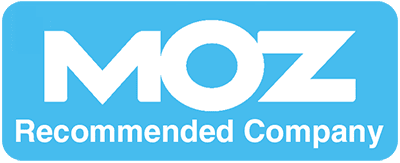Get ready to learn about content marketing and all of its benefits.
No, not those types of benefits…
In addition to having new, high-quality content, content marketing can also improve a variety of metrics that help you reach one (or more) marketing goals. Find out every benefit of content marketing in this week’s episode.
This podcast seeks to answer your questions about content marketing and digital PR with straightforward, actionable tips. You can find all episodes here.
I’ll be publishing weekly, so subscribe to stay up-to-date, and stay tuned for more special guests in the near future!
Have a marketing question you’d like featured on the show? Email me your question!
Episode 10: ALL of the Benefits of Content Marketing – Show Notes
This week’s question is one that’s been asked by our clients:
- What is Domain Authority? – Moz
- 5 Lesser-Known Benefits of Content Marketing [Fractl Blog Post]
Let’s Add Some Context, Shall We?
To answer this question in a way that’ll make sense to everyone who doesn’t work with Fractl, I first need to explain what we usually report on.
A lot of our work is based on getting high-quality media coverage and building links for our clients, so our reporting often includes a list of all the links, the link types (dofollow, nofollow, etc.), and link domain authorities we’ve secured with our content development and digital PR strategies.
And who doesn’t love links, right? Links are a sign of so many things, from portraying media coverage to demonstrating a healthier backlink portfolio.
While there are many other goals to aspire to as a digital marketer, let’s assume for this discussion that a hypothetical client has come to you wanting to build links.
So what are the benefits, other than link building?
Great question.
Like I said, for this hypothetical client, assume they’re hiring us to build links and that’s it. They probably just want our help completing one part of their grand marketing scheme.
And what could their end goal possibly be?
Increase organic traffic! The link building that results from content marketing + digital PR leads to a much healthier and more diverse backlink portfolio.
Having better backlinks = a better Google ranking = more organic traffic in the long run.
So, sure, content coverage you earn now can give you some referral traffic, but it can also help you make significant strides in improving your organic traffic numbers down the line.
But wait – there’s more! (Ugh, it kind of hurt to type that.)
Because your content is getting media coverage, you’re also inherently increasing your brand awareness. Brand awareness in itself means that more people know about you, increasing the pool of people with the potential to become customers or clients.
Once you’ve built up more brand awareness, you’re closer to the next tier up, which is brand authority. The more quality content you produce and promote, the more that people will come to respect and trust your brand.
And guess what?
When people are aware of your brand, if they search something in Google and see your site pop up in the results, they’re more likely to click it because they already like you.
That means an increase in organic traffic. (See? It’s all wonderfully symbiotic.)
Just a few more things to get psyched about…
Creating and promoting great content, which can get you links, increases in organic traffic, and more brand recognition, can also mean more conversions.
When people recognize you, respect you, and see you everywhere, when they do finally arrive at a landing page with a great call-to-action, they’ll be more likely to click through.
All of this content marketing work serves as a foundation for trust. And just because you can’t measure trust, doesn’t mean it’s not important.
Have a question you want to submit to the podcast?
Email me at [email protected] or comment below!
Have any additional insight on content marketing benefits? Post it in the comments! I’d love to hear your thoughts.
Full Transcript:
Amanda Milligan: Welcome to Ask Amanda About Marketing, a podcast in which I, Amanda, or occasionally a special guest, answer your questions about inbound marketing. Straightforward, right? If you want to submit a question, e-mail me at [email protected]. I’d love to hear from you. Let’s get right to it.
So I think I’ve mentioned this before but I live in DC and we don’t have central air. So I have an air conditioning unit in the window in my bedroom. And the reason I’m telling you this is that my podcast microphone was in my bedroom. I went upstairs to grab it and I heard a very loud buzzing sound which once I sent an image of this bug that I discovered to my co-workers on Slack, they identified as a black wasp. So there is a black wasp in my room. I darted out had to regain my cool for about 20 minutes. Ventured back into grab my mic and then ran back out.
Perhaps the scariest part is that when I went back in I didn’t see it anymore, which means it’s just lurking in there and at some point, I’m going to have to deal with this but for right now I have this podcast to get done.
So thank you for existing, listeners, so that I can deal with this at a later time. Now back to our regularly scheduled programming this week for episode 10. I can’t believe it’s been ten episodes already. We’re going to answer another client question because our account management team has done a great job of compiling some of the most typical questions we get from our clients and I think that if we answer them, it’s something that’s going to benefit all of you as well because if our clients are asking us these questions, odds are that other clients and other customers are going to be asking similar questions and I’m happy to help you form the answers to those inquiries. So this week’s common client question is:
Are there any benefits of what you do other than what you report to us?
To start this off, I want to explain what we typically report to our clients so you understand the context of this question. A lot of the work that our clients are looking for from us is from a link building capacity. So a lot of our reporting involves the number of links we’ve earned with our content and outreach strategies, the types of links, whether they’re dofollow links, nofollow links etc. And the domain authority of those links are reported on as well in order to get a better understanding of the quality of the links that we built. So I think the easiest way to approach this question is to assume that this hypothetical client’s goal when they came to us was to build links; but just to provide a little more background, this whole discussion about goal-oriented marketing is actually the reason why we decided to reorganize the Fractl site earlier this year and make it very goal specific.
And that’s because it’s easy to have multiple goals and to kind of mix your tactics up—trying to achieve too many things simultaneously and things can get a little confusing when you’re trying to tackle a lot of different initiatives for a lot of different reasons. So it makes way more sense to streamline things. Think, “what am I really trying to achieve at the end of the day here and why am I hiring somebody to do it for me?”
So there’s a lot of overlap but it’s still important to have that end goal in sight because it does affect the strategy that will lead to achieving that particular result that you’re looking for. That being said, I think that’s why it’ll be easier on this podcast to talk about one of those goals and then all of the additional benefits because it’s going to look a little different depending on what your goal is. So for the sake of this podcast, let’s assume that this hypothetical client wants to build links. That’s why they hired us. Maybe they have other strategic things going on internally and you know, they have things are going to do after with you know, the link building we’ve done for them, but they just want us to help the link building component.
So let’s talk about how a client who wants link building can see a lot of other benefits to content marketing outside of maybe that link report that we deliver.
The first thing I want to talk about is the benefit of increasing organic traffic in the long term. Maybe that’s actually the client’s end game but they’re working on a greater strategy internally and they just want to hire us, for example, for the link building side. But building quality links improving your backlink portfolio is a huge component of increasing your organic traffic over time. And the reason why is because building links to your site means Google’s going to favorite in the rankings and the higher ranked you are the more likely people are to click on your site when they search for something related to your brand. So that’s a huge benefit. If that’s not your primary goal. It’s a hugely beneficial secondary goal.
Another reason building links the way we do it which is through creating really great content and performing digital PR is that your brand name is getting out there which leads me to the second piece here, which is increasing brand awareness. There are so many benefits to increasing brand awareness. That’s a benefit in itself. And then it has auxiliary benefits that come as a result of your brand name being out there. So let me just start with the general. It’s also going to be the most obvious, which is that if while you’re building links more people know about who you are, that means more people are likely to become a customer or client. But once you started building this brand awareness—because you’re getting media coverage from all this great content, you’re creating or you’re on site content is really strong and people are really enjoying it. Then you’re also going to be building brand authority if your content is really high quality and you have really good solid publishers who are talking about the work you’ve done.
That’s absolutely going to build authority and again further increases your chances of getting new leads because there’s awareness and then one tier up is authority and trust. And link building can really help supplement the strength of all these different tiers that you can continue to build on them. Then consider how increasing your brand awareness compliments increasing organic traffic because the people have seen your brand and they’re starting to really trust your brand’s information and rely on you as a source then if they make a search query and your brand comes up as one of the top results, they’re going to be more likely to click on that because they’re already familiar with you and they already like your information and count on you. So that’s what I mean when a lot of this does overlap and you get a lot of complimentary benefits when you do content marketing work, but again still important to keep your eyes on what exactly you’re looking to achieve while also recognizing the other benefits you get from doing the work.
So let’s move on to number three, which is building social traction. If you’re creating content that’s either extremely valuable or extremely engaging or hopefully both and you’re getting a lot of attention on social media because people are sharing your content and they think a lot of people will benefit from it, then not only are you getting more brand awareness—just built in because people are sharing it and the contents getting more exposure—but also, a lot of the times, the sharing is coming from the coverage you’ve achieved through digital PR.
So you’re bolstering the authority and the relevancy and the value of that media coverage which is continuing to add authority to your content. And then Google sees this kind of social traction as a positive sign of authority of your brand and your site which can help increase your Google rankings again and thus contribute to increased organic traffic in the long term. Again, it is so fun to consider how all this works together and it’s really great. But you could be working towards one goal while still benefiting so many others.
The fourth point I want to talk about is attracting and converting potential customers. Now, this type of goal is more often going to be one that has the most different strategy than all the other goals just because you’re trying to convert people the content might look a little different and who you’re reaching out to might look a little different. It’s more of a niche approach and a lot of people go for the niche brand awareness approach too, but if you’re trying to attract and convert potential customers, you might be taking more of a focused route.
But that doesn’t mean that the great content you’re creating—the great coverage or the great engagement you’re getting—all of that still means that people are going to become aware of you and they’re going to trust you and if they already had in mind what they wanted and you land on their map and maybe some of your content—either, you know, off-site content with a great call to action or on-site content with a great call to action that they find that—all of this background of being familiar with you, understanding that you’re putting content out there that people appreciate—that’s all going to increase the chances are going to continue to read more about you and that ultimately when they land on that information that great call to action, they’ve had all of this lingering in their heads and they’re going to be more likely to take action. So even if it’s on a direct approach, a lot of this is foundational. The sad part is, it’s really hard to measure. So people undervalue it. But that doesn’t mean that it’s not important.
So finally I have some bonus benefits I want to talk about. Because, we’ve actually heard this from one of our clients who was talking about all the different benefits they got from working with us, which is always great to hear. And they said that in addition to just the increase in brand awareness that we typically hope for online, you know, just getting your name out there, they were getting more recognition that conferences like they were seeing that brand recognition reflected in real life, which is always really cool to see and they were getting more job applicants, you know, higher quality job applicants who are finding them out quote-unquote in the wild and that they were really interesting. So those are just some other things to consider. You don’t hire a content marketing agency usually with those things in mind like I want to get, you know, better people to apply for our open positions. But it just goes to show: you should pick a goal, pick the strategies and tactics that are going to work for you to achieve that goal, but also keep in mind how many other benefits you’re getting out of taking the content marketing route, particularly over other options.
It is just so widely encompassing in terms of how you’re communicating with your audiences, which even if you’re not measuring it or you’re not directly tracking it or you’re not even sure because you can’t get into the heads of everybody as much as we want to do as much as we try there’s a lot we can do but you will never be able to read minds. This is all still crucial and that’s why it’s important to be producing content, to be getting your name out there. Because it all has an impact on the general psyche of online audiences. So definitely keep this in mind. I mean, this is why I’m in this industry. I find it so fascinating how it all works together and how many different ways you can communicate with people effectively and provide value and what that means as a brand.
So, so many benefits. I’d be happy to talk about that more and if you have any I missed please post them in the comments on the blog post that we have on the page. You can find all of the show notes for each episode at frac.tl/blog and in particular, if you have any case studies or any examples of how content marketing has benefited you particularly—you and your brand—and in ways that you maybe didn’t expect, I would love to see that and I think a lot of others would too.
So feel free to reach out. You can either post a comment or email me. Again, that’s [email protected] and we can get a conversation going because I think a lot of the times also if you’re not talking to other people in the same industry, you’re not getting a full picture of what’s possible and how you are benefiting from this work. So I hope that the podcast is at least been helpful in that way.
Thanks again for listening! If you enjoyed this episode, click subscribe. Don’t leave me with the realization that I’m talking to no one and please rate and review on iTunes so I can keep making this podcast better and your lives easier. Take care.











Are there other benefits of what you do – other than what you’re reporting on?
Mentioned Links / Additional Resources: